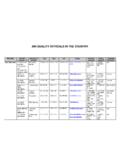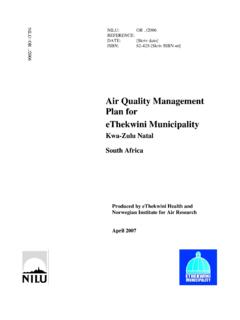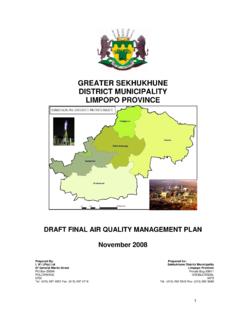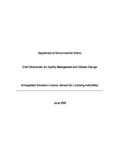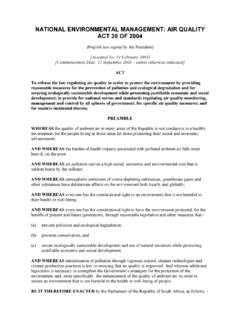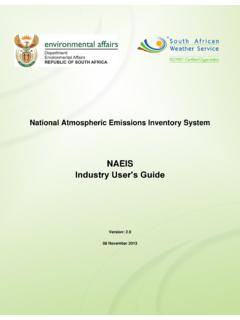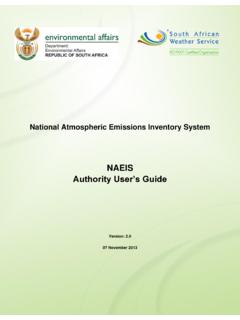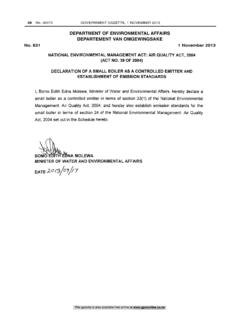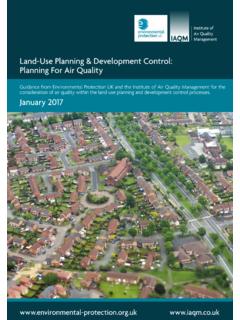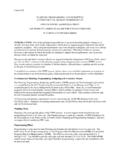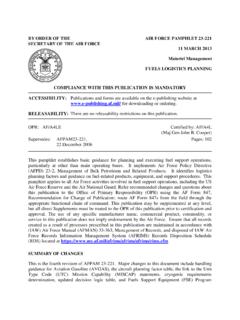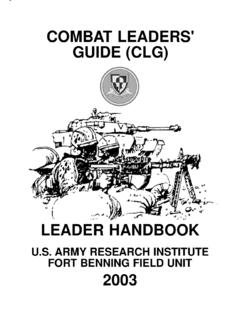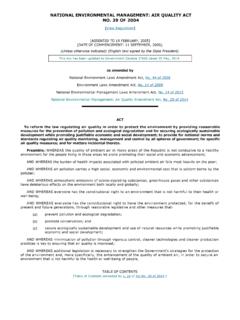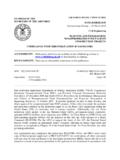Transcription of THE NATIONAL ENVIRONMENTAL …
1 THE NATIONAL ENVIRONMENTAL management : air quality ACT (ACT NO. 39 OF 2004), STANDARDS AND REGULATIONS 1 CONTENTS An introduction to the NATIONAL ENVIRONMENTAL management : air quality Act, 2004 (Act No. 39 of 2004, The AQA ) ..2 NATIONAL ENVIRONMENTAL management : air quality Act 39 of NATIONAL Ambient air quality NATIONAL Ambient air quality Standard for Particulate Matter with Aerodynamic Diameter Less Than Micron Metres ( )..101 List of activities which result in atmospheric emissions which have or may have a significant detrimental effect on the environment, including health, social conditions, economic conditions, ecological conditions or cultural Regulations prescribing the format of the Atmospheric Impact NATIONAL Dust Control Declaration of A Small Boiler as A Controlled Emitter And Establishment of Emission Declaration of Temporary Asphalt Plants as A Controlled Emitter and Establishment of Emission AQA Notices and Regulations as at 31 August 2 AN INTRODUCTION TO THE NATIONAL ENVIRONMENTAL management : air quality ACT, 2004 (ACT NO.)
2 39 OF 2004) AS AMENDED ( THE AQA ) INTRODUCTION With the rapid development of heavy industry in South Africa in the fifties and sixties came the associated rapid increase in atmospheric emissions and air pollution and the concomitant reduction of ambient air quality in the urban and industrial areas. By the late fifties there was a general consensus that some form of air pollution regulation was required and, by 1965, air quality management in South Africa was informed and regulated by the Atmospheric Pollution Prevention Act (Act No. 45 of 1965) (an Act that became known as the APPA ). The APPA itself was based on the British Alkali Act, a piece of legislation dating back to the late 1800s. The APPA, as with much environment protection legislation from this era, concentrated largely on industrial pollution and used a traditional command and control method of emission permitting for industries identified as being relatively significant sources of air pollution.
3 Although it could be argued that the APPA and the way that the APPA was implemented ensured that gross emissions of air pollution was, largely, prevented, it can also be argued that ambient air quality was not being sufficiently protected. Indeed, by the late 1980s concerns around ambient air quality had expanded from academic circles to many communities around the country. 3 THE NEW APPROACH TO air quality GOVERNANCE By the 1990s it was clear that a more modern approach to air quality regulation was required, an approach that was better aligned to South Africa s new Constitution and especially the right of all to an environment that is not harmful to health and well-being. To this end and informed by Government s Integrated Pollution and Waste management Policy of 2000, the development of a draft air quality Bill was initiated in late 2001. This new approach is an objectives or outcomes-based approach that takes the Constitution as its departure point.
4 In essence, the desired outcome of the efficient and effective implementation of this new legislation is NATIONAL air quality that is not harmful to health and well- being. The new legislation defines air quality that is not harmful to health and well-being through ambient air quality standards. The rest of the legislation then provides the regulatory tools and mandates for government to deliver the desired outcome. After a participatory development process that took three years of discussion and debate, the NATIONAL ENVIRONMENTAL management : air quality Act, 2004 (Act No. 39 of 2004, The AQA ) was made law by the President on 19 February 2005 and was brought into effect by the Minister on 11 September 2005 (with the exclusion of the provisions relating to atmospheric emission licensing). Once the Minister was convinced that the authorities responsible for implementing the AQA atmospheric emission licensing system were fully capacitated to fulfil this function, the remainder of the AQA was brought into effect on 1 April 2010.
5 4 AN OVERVIEW OF THE AQA The following provides a brief, chapter by chapter, overview of the AQA Chapter 1 The introductory chapter of the Act defines the specific terminology used, sets out the objectives of the Act and makes reference to the ENVIRONMENTAL management principles set forth in the NATIONAL ENVIRONMENTAL management Act, 1998 (Act No. 107 of 1998). Chapter 2 This chapter deals with the critical air quality governance matters, and is divided into three parts, namely, the establishment of the NATIONAL framework (Part 1); the establishment of ambient air quality standards and local emission standards (Part 2); and air quality monitoring and reporting (Part 3). Part 1: Establishment of the NATIONAL Framework This part requires the Minister to establish a NATIONAL framework within a specified timeframe. The part also sets out the air quality management matters that must be contained in the NATIONAL framework.
6 The former Minister of ENVIRONMENTAL Affairs and Tourism published the first generation NATIONAL Framework for air quality management in the Republic of South Africa on 11 September 2007. As contemplated in the AQA, the NATIONAL Framework must be reviewed by the Minister at intervals of not more than five years. In this regard, the Minister of Water and ENVIRONMENTAL Affairs published the second generation NATIONAL Framework for air quality management on 29 November 2012. The NATIONAL Framework is regarded as the NATIONAL implementation plan for the AQA. 5 Part 2: Establishment of NATIONAL and Provincial Ambient air quality Standards and Local Emission Standards NATIONAL and provincial ambient air quality standards This part provides for the identification of criteria pollutants and the setting of ambient standards in respect of these pollutants. To this end, the Minister and MEC are provided with the legal mandate to establish NATIONAL ambient air quality standards and provincial ambient air quality standards respectively.
7 However, in a situation where the Minister has established NATIONAL ambient air quality standards the MEC may not alter the NATIONAL standards except by establishing stricter standards for the province or for any geographical area within the province. As mentioned in the introduction, these standards define what constitutes ambient air that is not harmful to health and well-being. With this, ambient air quality standards provide the goals and objectives for all air quality management plans and the yardstick against which the efficacy of these plans can be measured. Furthermore, this part provides municipalities with a legal mandate to identify pollutants and establish local emission standards in respect of these pollutants. Part 3: Ambient air quality and Emission Measurements This part allows the Minister to prescribe the methods of measurements for ambient air quality as well as emissions from point, non-point or mobile sources.
8 The Section 9 notices ( NATIONAL Ambient air quality Standards) and Section 21 notice ( NATIONAL List of Activities and its Associated Minimum Emission Standards), sets out these methods of measurement. 6 Chapter 3 This chapter provides for the establishment of a NATIONAL air quality Advisory Committee whose object is to advise the Minister on any air quality related matter as the Minister may determine from time to time. The chapter also places a legal obligation on the Minister, MECs and all municipalities to designate an air quality officer within their respective administrations. The air quality officers are responsible for the coordination of air quality management activities as set out in the NATIONAL framework. Chapter 3 further deals with the development of air quality management plans in all spheres of government. In order not to duplicate the planning and reporting responsibilities of government, this chapter indicates how air quality planning must be integrated with existing activities, the plans required in terms of NEMA must incorporate a consideration of air quality whereas Integrated Development Plans compiled by municipalities must also take air quality into account.
9 Chapter 4 This chapter sets out the various regulatory tools or measures available to government for implementing and enforcing the Act, and is divided into six parts, namely, priority areas (Part 1); listing of activities resulting in atmospheric emissions (Part 2); controlled emitters (Part 3); controlled fuels (Part 4); other measures (Part 5); and measures in respect of dust, noise and offensive odours (Part 6). The tools have been designed in such a way as to ensure an optimal mix of regulatory approaches that will ensure that the diversity of air pollution issues can be managed in the most effective manner, with the least possible administrative burden and use of resources. 7 Part 1: Priority Areas This part provides the Minister and MEC the power to identify air pollution hot spots for focused attention. After the Minister or MEC declares an area as either NATIONAL priority area or provincial priority area, the NATIONAL air quality officer (in a case of NATIONAL priority area) or provincial air quality officer (in a case of provincial priority area) must develop an air quality management plan to be implemented to bring the area into compliance with ambient air quality standards.
10 Part 2: Listing of activities resulting in atmospheric emissions This part requires the Minister or MEC to identify and publish a list of activities which result in atmospheric emissions that require an atmospheric emission licence before they can operate. A list published by the Minister applies nationally and a list published by the MEC applies to the relevant province only. In addition, the list must contain minimum emission standards in respect of pollutants resulting from the activities. No person may undertake a listed activity without a provisional atmospheric emission licence or an atmospheric emission licence. Part 2 also details the consequences of the unlawful conduct of a listed activity resulting in atmospheric emissions. Part 3: Controlled emitters This part allows the Minister or MEC to identify certain classes of emitters and develop emission standards for such emitters. These are emitters not identified under Part 2, small boilers, temporary asphalt plants, fuel transfer points at petrol stations, etc.
